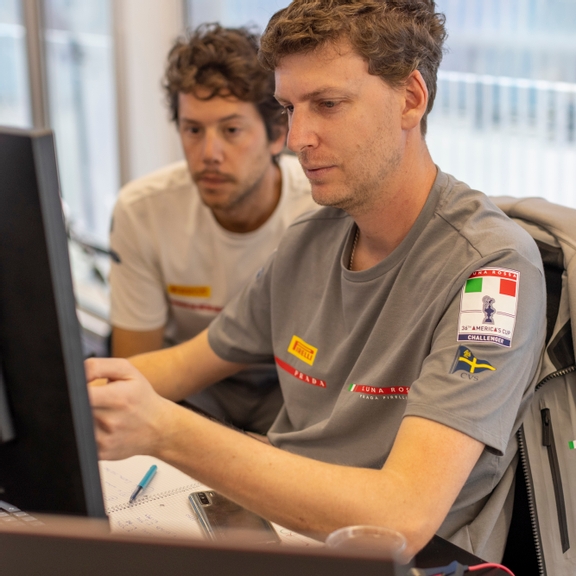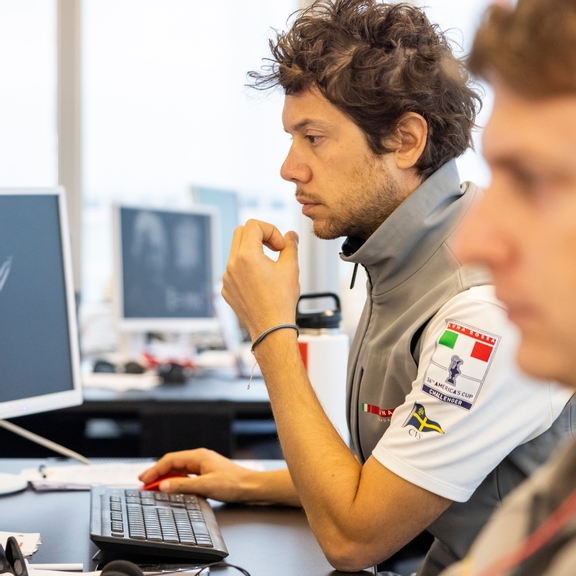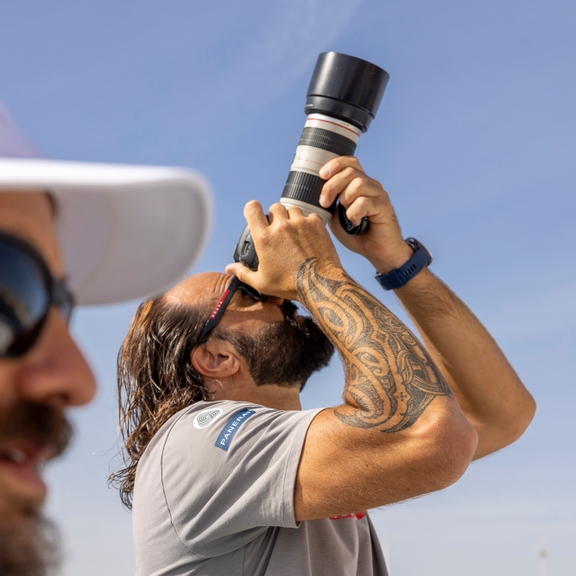DESIGN, SIMULATION AND PERFORMANCE
Andres Suar, Andrea Vergombello and Marco Capitani talk about their role in the design process, indicating key moments and objectives
The key words in the design of the Luna Rossa prototype (and the future AC75) are prediction, performance and control. From the hull to the sails, passing by foils, mechatronic software, deck layout and rig, everything must be conceived, built and tested like the pieces of a puzzle: each will have to fit perfectly with the one next to it and contribute to achieving maximum overall performance. The design department is therefore a large open space where people work synergically, letting ideas flow incessantly to reach a shared solution. Andres Suar (Naval Architecture), Andrea Vergombello (VPP) and Marco Capitani (Sail Design) explain how it works:
It's all a matter of 'scales'

A naval architect, Andres Suar was responsible for the hull design and the general naval architecture of the prototype (he will do the same for the new AC75). To get an overall view, he interfaces with those who carry out computer simulation of the aero and hydrodynamic fluids and those who design the appendages, to make sure there is a balance and that this represents the final AC75 well. «In the case of the prototype, as soon as the Class Rule was published, we started with our vision of the AC75 and based on that we chose the parts we wanted to test to scale», he explains. «The main difficulty is choosing what to scale: waves, for example, or people, cannot be 'scaled'. That is why it is important to understand beforehand what makes sense to test and what, instead, would only result in a waste of time. Furthermore, it is essential to be clear that what we want is not to test the hull, but that the hull responds to the individual components we want to test, always bearing in mind that this is not the boat that will race, but the one that must give us the information we need». Another problem lies in the restrictions imposed by the regulations for the LEQ12 prototype: there is a limitation on the length of the hull and how much you can scale, but the limits for mast and foil are different. «This means that we scale the individual parts to different sizes and then the hull will have to 'make them work'», he continues. A result of a generation in which computers and software are the undisputed protagonists, the prototype could also have been created on an old drawing board, explains Suar, albeit in a simplified form: «I think that from the point of view of naval architecture, you could also have designed it in the old way, because the first principals of yacht design still apply; what you can't do without software is to go into detail. Today thanks to computers we have an idea of how the boat will go, but it is the conceptual basis that is supported by the software and not the other way around». Can simulators replace sea trials altogether? «No, the simulator is a fundamental support, but it does not tell the whole story».
The static simulator

The speed and angle targets are also simulated by software, but the final answer will always come from the sea, as Andrea Vergombello explains. For Luna Rossa Prada Pirelli he oversees VPP (Velocity Prediction Program), i.e., prediction, performance and fluid-dynamic optimisation, with particular attention to the hydrodynamic profiles of the rudder and wing. «I come into play immediately, when the exploratory phase of the new boat begins», explains the aerospace engineer, «and I interface with all the departments: naval architecture (as far as the overall vision of the boat is concerned), hydrodynamics and aerodynamics. As far as my work is concerned, from a system, interface and input point of view, there is not much difference between the prototype and the big boat, because it is only the scale that differs. The hardest part is when you start going into so much detail, because the model has to be very refined to be able to capture the smallest differences». The aim of this long and complex work is to establish, thanks to VPP, how the boat would perform in an ideal world, sailing straight-line. «My job is to provide targets such as speed and angle, which the team will then use on the water», he explains. The VPP, then, is a static simulator, a kind of box (where all the boat's hydrodynamic and aerodynamic data, including weight, converge), which ultimately comes to a static solution. «In this way», says Vergombello, «we can compare various elements, individually changing parts of the boat such as wings, rudder and sails, and see which combination works best and achieves the best VMG (best approach to the mark and therefore shorter race time) ». The 'heart' of the VPP is software, that Vergombello links to other hydrodynamic computation tools and data received from other designers, first and foremost, the sail designers.
La vela perfetta tra forma e funzione

Marco Capitani and Juan Garay are in charge of the Sail Design department for Luna Rossa Prada Pirelli; they work alongside Michael Richelsen (CFD Aero), Nicolas Carabelli (VPP) and Gwénolé Bernard (soft wing system and mast) and are supported in the sail loft by two highly experienced sailmakers, Maximiliano Valli and Michele Bella. The wind is ultimately the sole driving force of a sailing yacht and the AC75 is no exception; this is why sails are a fundamental part of an America's Cup campaign. Capitani is sail designer for North Sails, the US sailmaker that supplies sails to all America's Cup teams, under strict codes of confidentiality and secrecy. From him we learn that designing the perfect sail is the ultimate goal, but not the only one: you need to know how to manage time, for example, considering that around six weeks pass between the delivery of the project and the day it will be used at sea, and you also need to have a long-term vision, so as not to run out of sailcloth in the final of the Challenger Selection Series, or, even worse, in the America's Cup Match. Which sails to keep last, which to use first? These are all difficult questions that only experienced people can answer. In the last edition of the Cup the "soft wing" was introduced, «made up of twin mainsails running parallel on a rotating mast with a 'D' shape and 20-25% more efficient than a classic mainsail, because the upwind and leeward wings can take different shapes», explains Capitani. «Hidden inside these two mainsails - from prying eyes but also from the wind so as not to offer resistance - are the systems that allow the shape of the two membranes to be modified. Active systems (those controlled directly by the crew), and passive systems (such as, for example, mast movement) can be used. The rules of the 37th America's Cup only allow active systems to be used in the lower part of the mainsail; in the upper part, only passive systems can be used». Given the complexity of this aero package, it is normal for the sailmakers to interface constantly with naval architects, with those who design the appendages, «each type of rudder or foil makes the boat sail at a different angle, so the sails will have different shapes and trims», with those who deal with structures «to make sure that the sail loads are properly supported», with those who deal with deck systems, with the mechatronics experts who will have to make the hydraulic, electrical and mechanical systems interact with each other, and, of course, with the sailors «our final customers», continues Capitani. As far as limitations are concerned, the sail designer explains that for the prototype, a maximum number of 13 jibs and 10 mainsails (i.e., 5 soft wings) can be built; for the AC75 there will be 15 jibs and 12 mainsails (6 soft wings). Only one mast may be built for the prototype and two for the AC75. Flyers and Code Zero are no longer required, while the smaller bowsprit will no longer be structural, but will serve as a support for the media/electronic systems. Every time Luna Rossa goes out to sea, even if only for training, the sail designers follow her from the support boat. «I look at the shape of the sails and at the same time I read the data on the 'flying shape', to understand if they are performing as designed or if something needs to be modified», continues Capitani. «Then, of course, it is crucial to get feedback from the sailors to understand how to trim them to get the most out of them. Once ashore, the sails are meticulously checked for any failures, folded and stowed for the next day». Does the ideal sail exist? «Yes», replies, «but it's not just a question of shape; the perfect sail must be a mix of shape, materials, control systems and structure, otherwise it's of no use...».